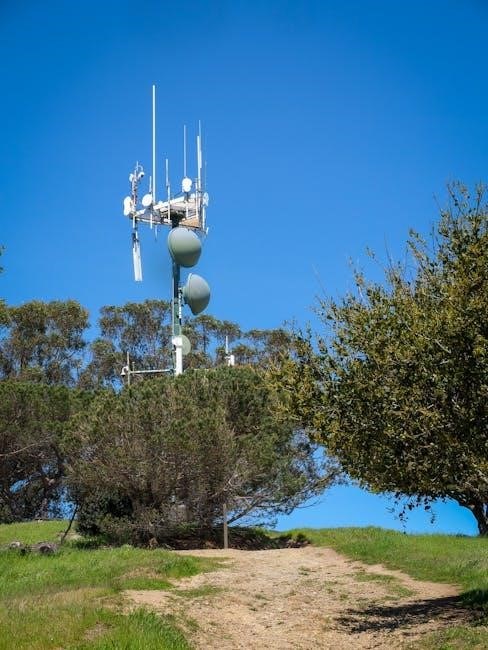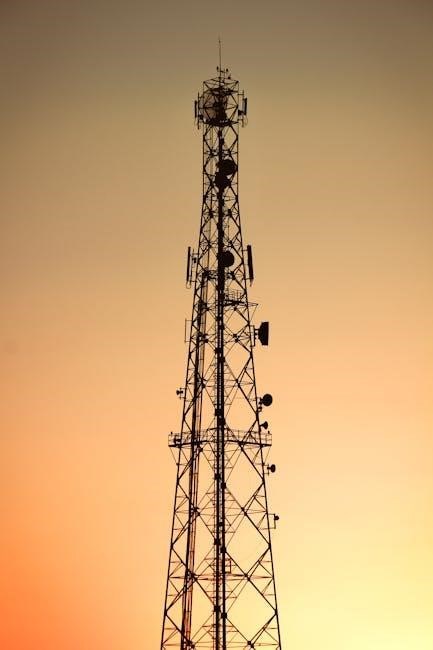A manual transmission remote start system allows starting a vehicle with a manual transmission from a distance, offering convenience while addressing unique challenges like clutch and gear engagement safely.
What is a Manual Transmission Remote Start?
A manual transmission remote start system enables starting a vehicle’s engine remotely, even with a manual transmission. It requires bypassing the clutch interlock and ensuring the car is in neutral and the parking brake is engaged. These systems use specialized safety features to prevent accidental starts in gear, making them compatible with manual transmissions while maintaining security and convenience for drivers.
History and Evolution of Remote Start Systems
Remote start systems originated for automatic transmissions, with manual transmissions posing unique challenges like clutch and gear engagement. Advances in technology have made manual transmission remote starts possible with specialized safety features and sensors to ensure safe operation and compatibility.
From Automatic to Manual: The Journey of Remote Start Technology
Remote start technology began with automatic transmissions, where systems could easily verify if the vehicle was in park. For manuals, the lack of a “park” position and the need to bypass the clutch interlock posed significant challenges. Early solutions were complex, but modern systems now seamlessly integrate with manual transmissions by using neutral safety switches and advanced sensors to ensure safety and prevent accidental starts in gear, making remote start accessible to manual vehicles.

Challenges of Remote Starting a Manual Transmission Vehicle
Starting a manual transmission vehicle remotely poses unique challenges, primarily ensuring the car is in neutral and bypassing the clutch interlock switch to prevent accidental movement and ensure safety.
The Role of the Clutch Interlock Switch
The clutch interlock switch is a critical safety feature in manual transmissions, preventing engine startup unless the clutch pedal is fully depressed. Bypassing this switch for remote start requires careful wiring to disable the interlock temporarily, ensuring the car doesn’t start in gear. This modification is essential for safe remote starting but must be done correctly to avoid potential accidents or vehicle damage.
Ensuring the Vehicle is in Neutral
For a manual transmission remote start to function safely, the vehicle must be confirmed in neutral. Modern systems use advanced sensors or wiring setups to verify neutral gear. This prevents accidental starts in gear, reducing risks of the car rolling or damage. Some systems integrate with the parking brake, ensuring it’s engaged before starting, while others use innovative sensors to monitor transmission position accurately. This step is crucial for safe operation.
Potential Dangers of Remote Start on Manual Transmissions
Remote starting a manual transmission vehicle can pose risks, such as the car rolling away if not properly in neutral, or accidental movement if the parking brake fails.
Risk of the Car Rolling Away
The primary danger of remote starting a manual transmission vehicle is the risk of the car rolling away if not properly secured. If the vehicle is not in neutral or the parking brake is not engaged, the car could move unexpectedly, leading to accidents or damage. Modern systems often include safety features like motion sensors and automatic shutdowns to mitigate this risk. Proper installation and strict adherence to safety protocols are essential to minimize this hazard.
Importance of Safety Features
Safety features are crucial in manual transmission remote start systems to prevent accidents. They ensure the vehicle is in neutral and the parking brake is engaged before starting. Advanced sensors, like Compustar’s FT-DAS-II, detect movement and halt the engine if the car moves without the key. These features prevent rollaways and unauthorized operation, making remote start systems safe and reliable for manual transmissions.
How to Install a Remote Start System on a Manual Transmission Vehicle
Installing a remote start system on a manual transmission vehicle requires bypassing the clutch interlock and verifying neutral gear engagement to ensure safe and proper operation.
Bypassing the Clutch Interlock
Bypassing the clutch interlock involves wiring the remote start system to simulate clutch pedal depression, enabling engine start without physical input. This is essential for manual transmissions, as the clutch interlock prevents starting in gear. Modern systems integrate with the clutch circuit to disable the interlock during remote start, ensuring safety by verifying neutral gear engagement before ignition. Proper installation is critical to avoid accidental vehicle movement.
Using a Neutral Safety Switch
A neutral safety switch ensures the vehicle is in neutral before remote starting, preventing accidental gear engagement. This switch monitors the transmission’s position and only allows the engine to start when neutral is confirmed. It integrates with the remote start system, enhancing safety by preventing unintended movement. Installation requires precise wiring to the transmission’s neutral sensor, ensuring reliability and compliance with safety protocols for manual transmission vehicles.
The Role of the Parking Brake
The parking brake plays a critical role in ensuring safety when using a remote start system on a manual transmission vehicle. It acts as a failsafe by preventing the vehicle from rolling or moving unintentionally. Many remote start systems require the parking brake to be engaged before the engine can be started remotely. This integration ensures the vehicle remains stationary, even if the transmission is inadvertently in gear, preventing potential accidents or damage.
Advanced Safety Features for Manual Transmissions
Modern systems include sensors like Compustar’s FT-DAS-II, which detects movement and shuts off the engine, ensuring the vehicle doesn’t move without the key present, enhancing safety and security.
Compustar’s FT-DAS-II Security Sensor
Compustar’s FT-DAS-II Security Sensor is a cutting-edge safety feature designed for manual transmissions. It uses an accelerometer to detect unauthorized movement, ensuring the vehicle doesn’t roll away. If movement is detected without the key present, the sensor immediately shuts off the engine, preventing potential accidents. This innovative solution provides peace of mind for manual transmission owners by enhancing the security and reliability of remote start systems.

Step-by-Step Installation Guide
Installing a manual transmission remote start system requires careful preparation. Key steps include bypassing the clutch interlock, wiring the system, ensuring the vehicle is in neutral, and testing the remote start. Professional installation is recommended for safety and reliability.
Pre-Installation Checks
Before installing a remote start system on a manual transmission vehicle, ensure the car is in neutral, the parking brake is engaged, and the clutch interlock is bypassed. Verify compatibility with your vehicle’s make and model. Check warranty terms, and consult a professional if unsure to avoid safety risks and potential damage.
Wiring the System
Wiring a remote start system for a manual transmission involves connecting the starter motor, bypassing the clutch interlock switch, and integrating with the parking brake sensor. Ensure all connections are secure and follow the manufacturer’s instructions. Proper wiring prevents errors and ensures safety features function correctly, such as neutral gear verification and emergency shutdown capabilities.
Testing the Remote Start
Testing the remote start system ensures proper functionality and safety. Begin by engaging the parking brake and shifting into neutral. Press the remote start button and verify the engine starts smoothly. Check that the system shuts off if the brake is disengaged or the clutch is pressed. Repeat the process several times to confirm reliability and ensure all safety features are operational, providing peace of mind for the user.

Top Remote Start Brands for Manual Transmissions
Compustar, Viper, and START IT are leading brands offering advanced remote start solutions for manual transmissions, ensuring safety and reliability with features like neutral detection and clutch bypass integration.
Compustar Remote Start Systems
Compustar offers advanced remote start systems designed for manual transmissions, featuring the innovative FT-DAS-II security sensor. This sensor ensures safety by detecting unauthorized movement and shutting off the engine if the vehicle moves without the key present. Compustar systems require the parking brake to be engaged and the transmission in neutral, providing a secure and reliable solution. Their products are known for ease of use, durability, and compatibility with a wide range of vehicles, making them a top choice for manual transmission owners seeking convenient and safe remote starting capabilities.
Viper Remote Start Solutions
Viper Remote Start Solutions offer advanced systems designed for manual transmissions, ensuring safe and reliable operation. Their systems integrate seamlessly with manual vehicles, addressing challenges like clutch engagement and neutral gear verification. Viper’s remote starters include features like automatic transmission checks and parking brake integration, ensuring the vehicle is secure before starting. With a strong reputation for quality and reliability, Viper provides a user-friendly experience, making it a popular choice for manual transmission owners seeking convenient remote start functionality.
START IT Remote Start Technology
START IT offers innovative remote start solutions specifically designed for manual transmissions. Their systems require reservation mode activation, confirming the parking brake is engaged and the vehicle is in neutral. This ensures safe starting without the risk of movement. With advanced safety protocols and user-friendly operation, START IT provides a reliable and secure remote start experience for manual transmission vehicles, prioritizing both convenience and safety effectively.

Legal and Warranty Considerations
Installing a remote start on a manual transmission may void your vehicle’s warranty. Always check the manufacturer’s terms and consult local laws regarding remote start systems. Ensure compliance with safety regulations to avoid legal issues and maintain warranty coverage. Brands like Compustar offer systems with built-in safety features to help meet these requirements.
Understanding Your Vehicle’s Warranty
Installing a remote start system on a manual transmission vehicle may void your car’s warranty. Always review your manufacturer’s terms to ensure compliance. Some systems, like those from Compustar, include features that maintain warranty compliance by adhering to safety and operational standards. Consult your dealership or installer to confirm compatibility and avoid potential disputes. Proper documentation and professional installation can help preserve your warranty while enjoying the convenience of remote start technology.
Legal Implications of Remote Start Installation
Installing a remote start system on a manual transmission vehicle may have legal implications. Check local laws, as some jurisdictions regulate remote start systems for safety and emissions compliance. Improper installation can lead to liability if the vehicle causes damage or injury. Ensure compliance with manufacturer guidelines and consider professional installation to avoid legal issues. Always verify that the system meets local regulations to prevent potential penalties or disputes with authorities.
Manual transmission remote start technology is evolving, offering safer and more reliable solutions. Future advancements promise enhanced convenience and compatibility, making remote starts more accessible for manual vehicles.
The Future of Remote Start Technology
Advancements in remote start technology for manual transmissions focus on enhanced safety and convenience. Future systems will likely integrate seamlessly with modern vehicles, offering improved smartphone app controls and advanced sensors to prevent accidental starts. Innovations like Compustar’s FT-DAS-II sensor highlight the direction toward smarter, safer solutions. As technology evolves, remote starts for manual transmissions will become more accessible and user-friendly, ensuring reliability and peace of mind for drivers worldwide.
Final Thoughts on Manual Transmission Remote Start
Manual transmission remote start systems offer convenience but require careful installation and adherence to safety protocols. While they provide ease of use, potential risks like unintended movement must be mitigated with features like neutral confirmation and parking brake integration. Trusted brands like Compustar and Viper offer reliable solutions, ensuring safety and functionality. Proper installation by professionals is key to enjoying the benefits without compromising vehicle safety or performance.